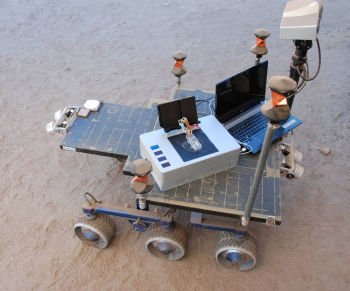Will the “Chemical Laptop” Find Extraterrestrial Life? – Scientists’ next tool in the search for extraterrestrial life might be the “Chemical Laptop.” The miniaturized, portable laboratory analyzes samples to look for materials that may indicate the presence of life.
Specifically, the device tests for amino acids and fatty acids. Both are considered essential ingredients of organic life, but can also exist in non-living sources. The Chemical Laptop is designed to tell the difference.
The device is about the size of a laptop computer, but much thicker to provide space for the chemical analysis components inside.
The NASA JPL development team hopes to see the device deployed on future exploratory missions, such as those planned for Mars and eventually Europa.
Chemical Laptop’s “Expresso machine” technology liquefies samples for analysis.
The Chemical Laptop requires a liquid sample to perform its analysis. This can be difficult in environments like that of the surface of Mars, where liquids are scarce.
With this issue in mind, the team devised an “expresso machine” design.
Samples are added to a tube containing liquid water, then heated to more than 212 degrees Fahrenheit (100 degrees Celsius). The water that comes out carries organic molecules with it.
Once the water sample feeds into the Chemical Laptop, the device mixes it with a fluorescent dye. This dye attaches itself to the amino and fatty acids.
This sample then flows into a microchip that separates the acids from one another.
The end of the separation channel contains a detection laser which sees a signal corresponding to the amino or fatty acids as they pass.
Determining “handedness” to seek signs of life.
Amino acids exist in “right-handed” and “left-handed” configurations that are mirror images of each other. Life on Earth uses only left-handed amino acids.
The current hypothesis is that life adopted this left-handed standard early on in its history. It is thought that life on other worlds may use right-handed amino acids as building blocks for life.
Amino acid analysis is particularly challenging because the left- and right-handed versions are equal in size and electric charge.
To accommodate this, the team uses chemical additives inside the microchip that mix with the sample. Some of these additives will only interact with right-handed amino acids, while others will only interact with the left-handed variety.
This means the additives will change the relative amount of time that the left and right-handed amino acids are in the separation channel. This will allow scientists to determine the “handedness” of the amino acids within the sample.
“If a test found a 50/50 mixture of left-handed and right-handed amino acids, we could conclude that the sample was probably not of biological origin,” said Jessica Creamer, a NASA postdoctoral fellow at JPL. “But if we were to find an excess of either left or right, that would be the golden ticket. That would be the best evidence so far that life exists on other planets.”
When the device is set to look for fatty acids, the length of the acids’ carbon train is most interesting to the scientists. This is because the carbon chains will indicate if organisms are or were once present in the sample.
Field tests for space missions and applications on Earth.
So far the team has completed one field test with the Chemical Laptop technology. Another is coming up in the near future.
Last year’s test at JPL’s Mars Yard saw the laptop riding a test rover and analyzing a sample of “green rust.” This is a mineral that absorbs organic molecules in its layers and could be significant to the origin of life.
 “This was the first time we showed how the instrument works outside of the laboratory setting,” said Fernanda Mora, one of the JPL technologists developing the instrument. “This is the first step toward demonstrating a totally portable and automated instrument that can operate in the field.”
“This was the first time we showed how the instrument works outside of the laboratory setting,” said Fernanda Mora, one of the JPL technologists developing the instrument. “This is the first step toward demonstrating a totally portable and automated instrument that can operate in the field.”
Peter Willis, the project’s principal investigator adds, “One ultimate goal is to put a detector like this on a spacecraft such as a Mars rover. So for our first test outside the lab we literally did that.”
Since this test, Mora and the team have been working to improve the Chemical Laptop’s sensitivity.
Currently the instruments can detect concentrations as low as parts per trillion. They aim to enable it to detect even smaller amounts of amino and fatty acids.
Toward this end, the team is also testing a new laser and detector technology.
Though the team acknowledges the challenges of getting liquid samples in dry environments like Mars, Creamer points out that, “this could be an especially useful tool for icy-worlds targets such as Enceladus and Europa. All you would need to do is melt a little bit of the ice and you could sample it and analyze it directly.”
Coming up is a field test in Chile’s Atacama Desert, in collaboration with NASA’s Ames Research Center.
Source: nasa




